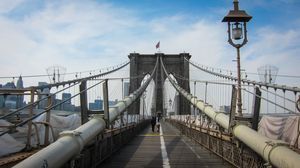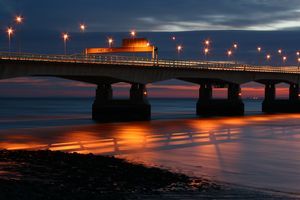Types of Suspension Bridges
Suspension bridges are bridges whose deck is held in place by suspender cable which hang vertically from suspension cables. But they are not all the same. They use different techniques and materials to achieve the same thing – span distances that could not be crossed differently.
- “Simple suspension bridge” is a bridge that has no towers nor piers and is suspended on the cables that are anchored at their ends and nothing else. It is also known as a rope bridge, swing bridge, suspended bridge, hanging bridge and catenary bridge and is the oldest variant of the suspended bridge. The deck of this bridge follows is arched downwards and upwards and has additional ropes at a higher level which form the handrail. It is a pedestrian bridge and cannot carry modern roads and railroads. "Simple-suspension bridge" can also be name for a suspended deck bridge that has a deck which is not stiffened, hence - "simple".

- “Suspension bridge” is a name for a modernly designed suspension bridge – a suspended-deck suspension bridge. It has towers and, from them, cables that hold up the road deck. These cables transfer the weight of the deck, by tension, to the towers and then to the ground by cables whose ends are anchored. This type can carry heavy vehicles and light rail. The first designs of this type of bridge appeared in 16th century but they were not built until 18th century when more materials appeared which allowed for this type of bridge to be made. Longest suspension bridges of today are of this design.
- “Underspanned suspension bridge” is a type of bridge that was developed in the early 19th century and which has deck that is raised on posts above the main cables which are, at their ends, anchored. It is a very rare design in practice because its deck is not too stable. Some of the bridges built like this are Pont des Bergues (built in 1834), are James Smith’s Micklewood Bridge at Doune in Scotland (it was probably the first one built like this and had chains instead of cables which also makes it chain bridge). Hammersmith Bridge has parts of the roadway built in this manner.
- “Stressed ribbon bridge” is a modern, improved variant of a classical simple suspension bridge. It has a rigid deck which lays on suspension cables which are in turn embedded in the deck. Deck follows a catenary arc between supports and is stressed in traction, which adds to its stiffness and prevents swaying and bouncing like at simple suspended bridge. This bridge is usually made of concrete reinforced by steel tensioned cables and can carry vehicle traffic. Concrete plates are premade and placed to form the initial structure. Sandbags are place upon the tiles to prestress cables that hold the tiles and gaps between the tiles are filled with concrete. When the concrete dries, sandbags are removed and cables compress, stiffening the bridge and making it more durable.
- "Self-anchored suspension bridge" has its main cables attached to the ends of the deck rather than ground like standard suspended bridge which allows for construction on elevated piers, or in areas of unstable soils where anchors would be loosen over time. This method of building appeared in mi-19th century and was designed by Austrian engineer Josef Langer in 1859. American engineer Charles Bender patented this method in United States in 1867. Earliest bridges built with this method in United States were Three Sisters Bridges of Pittsburgh, built between 1924 and 1928. Suspension cables cannot be anchored until the deck is finished with this design so a false-work is used to hold them until then.


